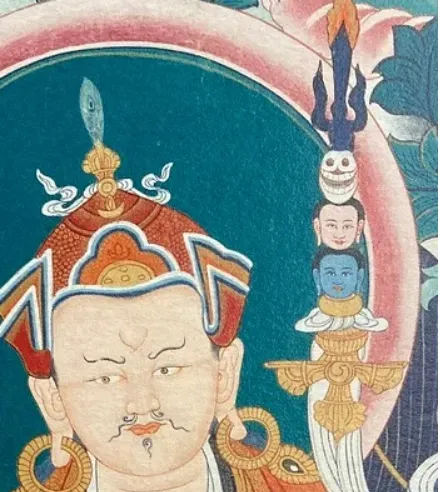| Home » » 雙身法喇嘛教(西藏密宗、偽藏傳佛教)秘密大公開 |
荒謬絕倫——伏藏師的發掘力居然和是否男女交合息息相關 |
伏藏,傳說是殺人如麻的蓮華生所開創的手法,但其常為伏藏師本人杜撰、埋藏後並發掘,為學者之共識。 且以蓮華生一生淫人妻女不可計數,外加算計權力、謀劃奪取他人財物等,他不可能有時間和能力進行寫作。 更何況一個貪嗔痴三毒炙盛、殘暴好殺、陰狠毒辣、奸淫無數女性的假佛法大師,他傳的譚崔邪法, 即便被刻在金條埋在地底,又有何珍貴之處呢?髒了那些黃金。
這怎麼可能是佛門修行人的所作所為? 譯文: 鑒於蓮華生本人與譚崔明妃空行母的操練,所以密宗譚崔明妃對於伏藏師來說極其重要就毫不意外。伏藏師,據說是一個世紀之前被蓮華生掩藏的文本和工藝品的發現者、發掘者。一般來說,在伏藏師獲得他們主要的發掘 之前,他們要與明妃練習性瑜伽,以做為一種促進和增強他們的遙視能力(Visionary Power)的方式。據說,一位當代的伏藏師拒絕和明妃進行性瑜伽的練習,因此而延遲了他發掘伏藏(寶藏)的能力。當他後來開始再一 次發掘寶藏,他的缺少性伴侶導致他出土的蓮花生雕像缺少傳統的手持三叉戟,而三叉戟被理解為是代表明妃的像征。另一位伏藏師,噶瑪林巴(Karma Glingpa),第十四世紀《西藏度亡經》(Tibetan Book of the Dead, 傳為蓮華生所作)的發現者,據信死得早是因為他沒有能力找到已經事先為他安排好的女人(雙修)。由此可見,女性伏藏師Jomo Manmo (1248-1283) 在擁有一個性伴侶之前就發掘了文本的事實,提出一個問題,即是否 女性的伏藏師真的需要一個男性的性伴侶,或者是女性天生而有的(敏感)能力,透過意識的訓練而增強,所以足夠完成(發掘)的任務。 英文原文: Given Padmasambhava’s own practice with tantric consorts, it is no surprise that tantric consorts are extremely important to tertons (gterton), the discoverers of texts and other artifacts believed to have been hidden by Padmasambhava centuries before. Generally, before receiving their main revelations, tertons practice sexual yoga with a consort 40.David Germano, “Re-membering the Dismembered Body of Tibet: Contemporary Tibetan Visionary Movements in the People’s Republic of China,” in 41.Germano, “Re-membering,” 169. 42.Eva M. Dargyay, The Rise of Esoteric Buddhism in Tibet (Delhi: Motilal Banarsidass,1977), 152. 43.Dar gyay, Rise of Esoteric Buddhism, 119-23. Another short biography of her is in Tsultrim Allione, Women of Wisdom (London: Routledge & Kegan Paul, 1984). 出處: Serinity Young,Courtesans and Tantric Consorts——Sexualities in Buddhist Narrative,Iconography,and Ritual,P155.
|
| Home » » 雙身法喇嘛教(西藏密宗、偽藏傳佛教)秘密大公開 |

简体 | 正體 | EN | GE | FR | SP | BG | RUS | JP | VN 西藏密宗真相 首頁 | 訪客留言 | 用戶登錄 | 用户登出
- 評論南傳佛教上座部及印順法師
- 喇嘛教本質的海濤法師放生爭議
- 雙身法黃教祖師--宗喀巴(廣論)淫人妻女秘密大公開
- 淨空法師揭發邪惡之偽藏傳佛教開示輯
- 慧律法師破斥藏傳假佛教及「人間佛教」之邪說
- 淫人妻女之活佛喇嘛(偽藏傳佛教)性侵害事件秘密大公開
- 雙身法六字大明咒秘密大公開
- 十七世大寶法王噶瑪巴性醜聞
- 高僧學者名人批判雙身法之西藏密宗(偽藏傳佛教)證據大公開
- 藏密本質的聖輪法師性醜聞事件簿
- 雙身法達賴喇嘛秘密大公開
- 殘暴的偽藏傳佛教、西藏密宗、喇嘛教殺人證據
- 宗教性侵防治文宣教育(歡迎流通)
- 雙身法喇嘛教(西藏密宗、偽藏傳佛教)秘密大公開
- 雙身法紅教祖師--蓮花生(大圓滿)淫人妻女秘密大公開
- 雙身法白教祖師--密勒日巴(大手印)淫人妻女秘密大公開
- 真心新聞網、各家宗教新聞
- 漫畫-密宗活佛、喇嘛、仁波切
- 喇嘛教雙身法連載專欄:台灣玉教室
- 偽藏傳佛教雙身法分享專欄:-讀者來鴻
- 罪惡達賴 罪惡時輪
- 偽藏傳佛教(藏密)問答錄●學密基本常識
- Swami瑜伽性侵大師
- 人面獸心-索達吉堪布雙修大揭密
- 國學大師-南懷瑾雙修大揭密
- 卡盧仁波切雙修大揭密
- 索甲仁波切雙修大揭密
- 真佛宗盧勝彥雙修大揭密
- 破斥藏密多識喇嘛《破魔金剛箭雨論》之邪說
- 陳健民上師講述如何修學密宗邪淫男女雙修灌頂
- 剖析天鑒網悲智版主愚癡言論輯
- 嗜血啖肉的人間羅剎---喇嘛教絕非佛教
- 嗜食糞尿精血等穢物的藏傳佛教
- 附佛外道-法輪功的秘密
- 揭發「藏傳佛教」轉世活佛的騙人內幕
- 認識真正善知識-蕭平實老師
- 偽藏傳佛教詩詞賞析
- 第一部揭開西藏神秘面紗的大戲--西藏秘密
- 破斥遼寧海城大悲寺妙祥法師抵制正法
- 破斥一貫道
- 破斥瑯琊閣
佛教未傳入西藏之前,西藏當地已有民間信仰的“苯教”流傳,作法事供養鬼神、祈求降福之類,是西藏本有的民間信仰。
到了唐代藏王松贊干布引進所謂的“佛教”,也就是天竺密教時期的坦特羅佛教──左道密宗──成為西藏正式的國教;為了適應民情,把原有的“苯教”民間鬼神信仰融入藏傳“佛教”中,從此變質的藏傳“佛教”益發邪謬而不單只有左道密宗的雙身法,也就是男女雙修。由後來的阿底峽傳入西藏的“佛教”,雖未公然弘傳雙身法,但也一樣有暗中弘傳。
但是前弘期的蓮花生已正式把印度教性力派的“双身修法”帶進西藏,融入密教中公然弘傳,因此所謂的“藏傳佛教”已完全脱離佛教的法義,甚至最基本的佛教表相也都背離了,所以“藏傳佛教”正確的名稱應該是“喇嘛教”也就是──左道密宗融合了西藏民間信仰──已經不算是佛教了。


